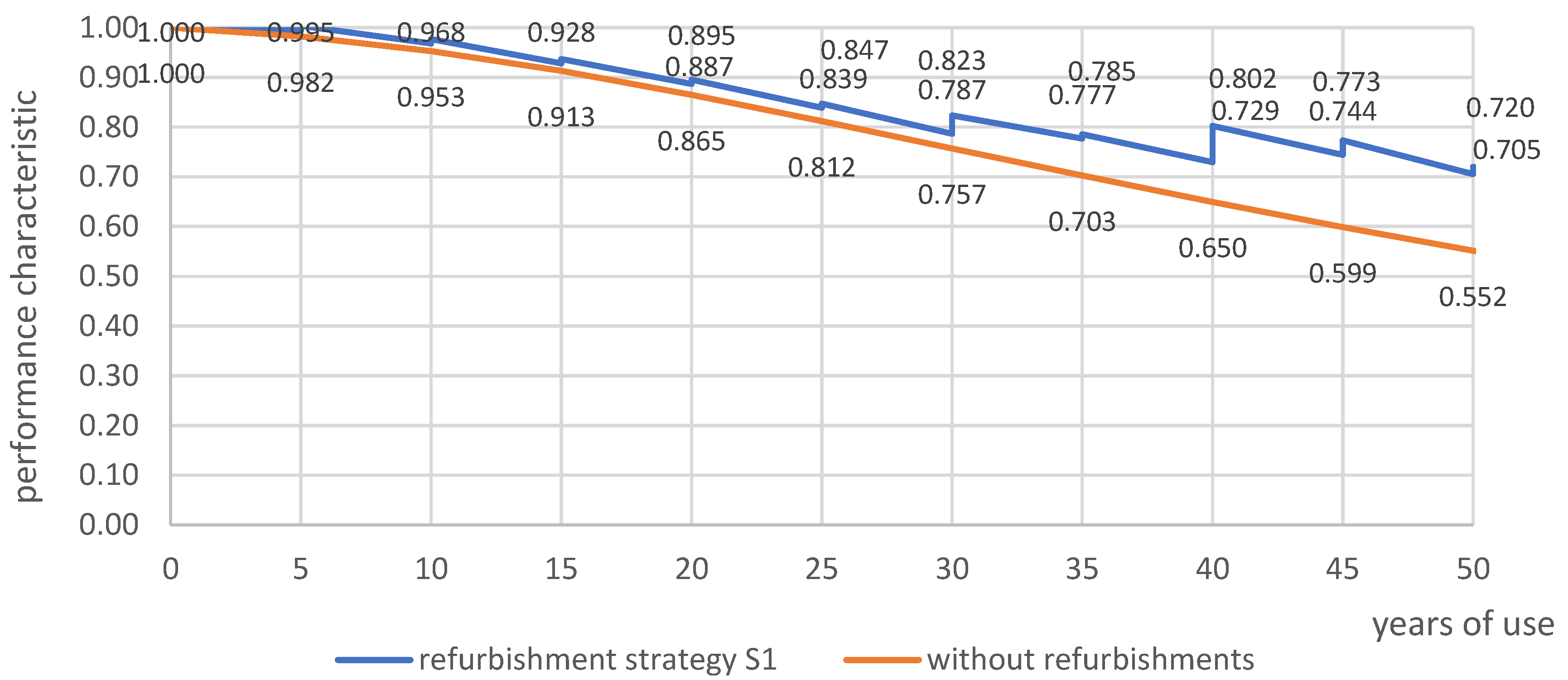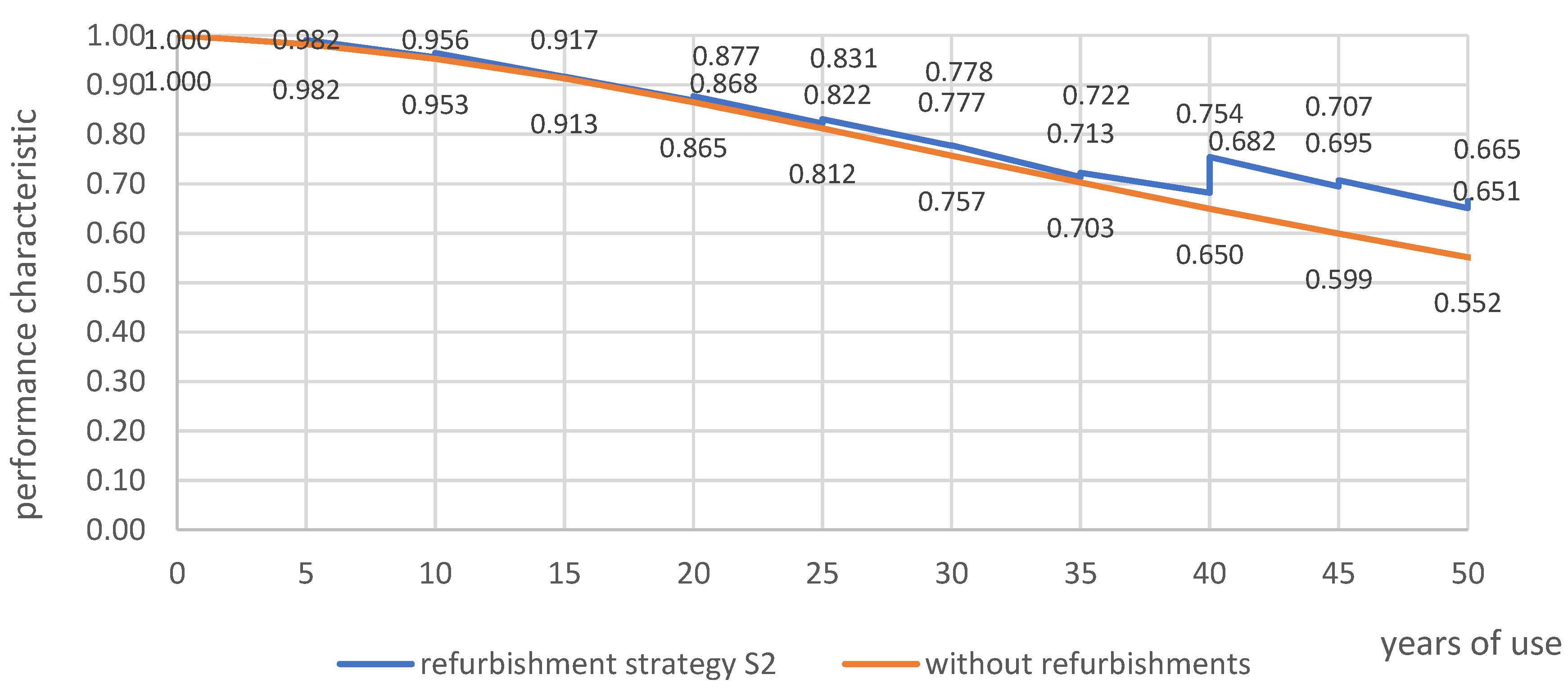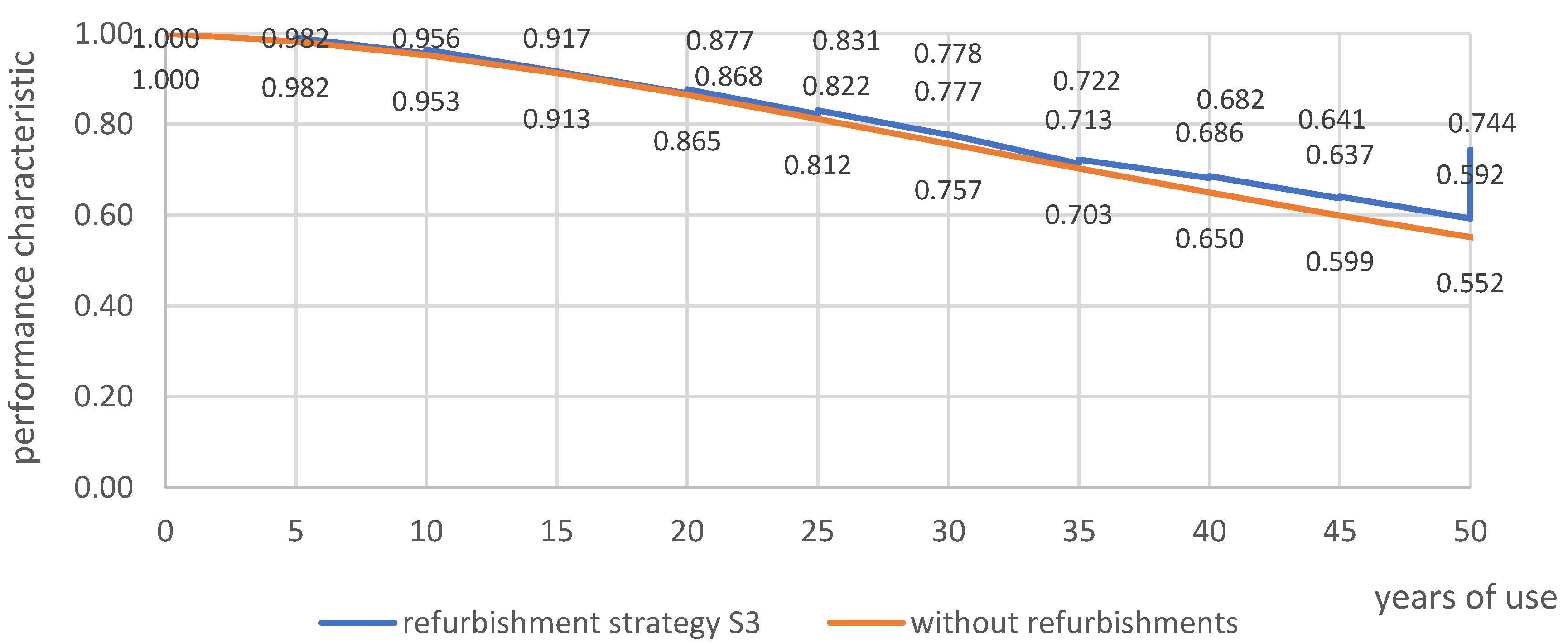Method of Planning Repairs of the Installation including Building Waste
Abstract
:Featured Application
Abstract
1. Introduction
- Class A—waste that can be reused or recycled as aggregate.
- Class B—waste that can be recycled for other purposes, e.g., plastics, paper, metals, glass or wood.
- Class C—waste for which economically viable technologies or applications that allow for recycling or reuse have not been developed. This class includes products derived from plastering.
- Class D—hazardous waste from the construction process.
2. Materials and Methods
- Adoption of the main assumptions of the method;
- Analysis of the strategy S1—the refurbishment of the installation was carried out in the 30th year of operation;
- Strategy analysis S2—the installation was refurbished in the 40th year of operation;
- Strategy analysis S3—system failure in the 50th year of operation.
2.1. Main Principles of the Method
2.2. Analysis of the Strategy of Proceeding S1
2.3. Analysis of the Strategy of Proceeding S2
2.4. Analysis of the Strategy of Proceeding S3
3. Analysis of the Results Obtained and Discussion
4. Conclusions
Author Contributions
Funding
Institutional Review Board Statement
Informed Consent Statement
Data Availability Statement
Conflicts of Interest
References
- Silva, A.; de Brito, J.; Gaspar, P.L. Methodologies for Service Life Prediction of Buildings; Springer International Publishing: Zurich, Switzerland, 2016; Volume VII, p. 432. [Google Scholar] [CrossRef]
- Farahani, A.; Wallbaum, H.; Dalenbäck, J.-O. Optimized maintenance and renovation scheduling in multifamily buildings—A systematic approach based on condition state and life cycle cost of building components. Constr. Manag. Econ. 2018, 37, 139–155. [Google Scholar] [CrossRef] [Green Version]
- Skrzypczak, I.; Oleniacz, G.; Leśniak, A.; Zima, K.; Mrówczyńska, M.; Kazak, J. Scan-to-BIM method in construction: Assessment of the 3D buildings model accuracy in terms inventory measurements. Build. Res. Inf. 2022, 50, 1–22. [Google Scholar] [CrossRef]
- Konior, J.; Sawicki, M.; Szóstak, M. Intensity of the Formation of Defects in Residential Buildings with Regards to Changes in Their Reliability. Appl. Sci. 2020, 10, 6651. [Google Scholar] [CrossRef]
- Biolek, V.; Hanák, T. LCC Estimation Model: A Construction Material Perspective. Buildings 2019, 9, 182. [Google Scholar] [CrossRef] [Green Version]
- Moretti, N.; Re Cecconi, F. A Cross-Domain Decision Support System to Optimize Building Maintenance. Buildings 2019, 9, 161. [Google Scholar] [CrossRef] [Green Version]
- Rivera-Gómez, H.; Montaño-Arango, O.; Corona-Armenta, J.R.; Garnica-González, J.; Hernández-Gress, E.S.; Barragán-Vite, I. Production and Maintenance Planning for a Deteriorating System with Operation-Dependent Defectives. Appl. Sci. 2018, 8, 165. [Google Scholar] [CrossRef] [Green Version]
- Hoła, A.; Sadowski, Ł.; Szymanowski, J. Non-Destructive Testing and Analysis of a XIX-Century Brick Masonry Building. Arch. Civ. Eng. 2020, 66, 201–219. [Google Scholar]
- Piasecki, M.; Radziszewska-Zielina, E.; Czerski, P.; Fedorczak-Cisak, M.; Zielina, M.; Krzyściak, P.; Kwaśniewska-Sip, P.; Grześkowiak, W. Implementation of the Indoor Environmental Quality (IEQ) Model for the Assessment of a Retrofitted Historical Masonry Building. Energies 2020, 13, 6051. [Google Scholar] [CrossRef]
- Bento Pereira, N.; Calejo Rodrigues, R.; Fernandes Rocha, P. Post-Occupancy Evaluation Data Support for Planning and Management of Building Maintenance Plans. Buildings 2016, 6, 45. [Google Scholar] [CrossRef] [Green Version]
- Morelli, M.; Lacasse, M.A. A systematic methodology for design of retrofit actions with longevity. J. Build. Phys. 2019, 42, 585–604. [Google Scholar] [CrossRef]
- Lounis, Z.; Vanier, D.J.; Lacasse, M.A.; Kyle, B.R. Decision-Support System for Service Life Asset Management: The BELCAM Project. In Durability of Building Materials and Components; National Research Council Canada: Ottwa, ON, Canada, 1999; Volume 4, pp. 2338–2347. [Google Scholar]
- Alshubbak, A.; Pellicer, E.; Catala, J.; Teixeira, J. A Model for identifying owner’s needs in the building life cycle. J. Civ. Eng. Manag. 2015, 21, 1046–1060. [Google Scholar] [CrossRef] [Green Version]
- Vanier, D.; Tesfamariam, S.; Sadiq, R.; Lounis, Z. Decision models to prioritize maintenance and renewal alternatives. In Proceedings of the Joint International Conference on Computing and Decision Making in Civil and Building Engineering, Montréal, QC, Canada, 14–16 June 2006; pp. 2594–2603. [Google Scholar]
- Branco, P.J.; Paiva, P.J. Assessment method of buildings’ rehabilitation needs: Development and application. In Proceedings of the CIB World Congress, Salford, UK, 10–13 May 2010. [Google Scholar]
- Serrano-Jiménez, A.; Lima, M.L.; Molina-Huelva, M.; Barrios-Padura, Á. Promoting urban regeneration and aging in place: APRAM—An interdisciplinary method to support decision-making in building renovation. Sustain. Cities Soc. 2019, 47, 101505. [Google Scholar] [CrossRef]
- Paulo, P.V.; Branco, F.; De Brito, J. BuildingsLife: A building management system. Struct. Infrastruct. Eng. 2013, 10, 388–397. [Google Scholar] [CrossRef]
- Nowogońska, B. A Methodology for Determining the Rehabilitation Needs of Buildings. Appl. Sci. 2020, 10, 3873. [Google Scholar] [CrossRef]
- Shiue, F.-J.; Zheng, M.-C.; Lee, H.-Y.; Khitam, A.F.; Li, P.-Y. Renovation Construction Process Scheduling for Long-Term Performance of Buildings: An Application Case of University Campus. Sustainability 2019, 11, 5542. [Google Scholar] [CrossRef] [Green Version]
- Sherwin, D. A review of overall models for maintenance management. J. Qual. Maint. Eng. 2000, 6, 138–164. [Google Scholar] [CrossRef] [Green Version]
- Wahi, N.; Joseph, C.; Tawie, R.; Ikau, R. Critical Review on Construction Waste Control Practices: Legislative and Waste Management Perspective. Procedia Soc. Behav. Sci. 2016, 224, 276–283. [Google Scholar] [CrossRef] [Green Version]
- Pawluk, K. Recovery and recycling of waste from the construction industry (in Polish: Odzysk i recycling odpadów z branży budowlanej). Logistyka Odzysku 2016, 21, 62–65. [Google Scholar]
- Ghaffar, S.H.; Burman, M.; Braimah, N. Pathways to circular construction: An integrated management of construction and demolition waste for resource recovery. J. Clean. Prod. 2020, 244, 118710. [Google Scholar] [CrossRef]
- Alencar, L.H.; Mota, C.M.D.M.; Alencar, M.H. The problem of disposing of plaster waste from building sites: Problem structuring based on value focus thinking methodology. Waste Manag. 2011, 31, 2512–2521. [Google Scholar] [CrossRef]
- Banias, G.; Achillas, C.; Vlachokostas, C.; Moussiopoulos, N.; Tarsenis, S. Assessing multiple criteria for the optimal location of a construction and demolition waste management facility. Build Environ. 2010, 45, 2317–2326. [Google Scholar] [CrossRef]
- Sormunen, P.; Kärki, T. Recycled construction and demolition waste as a possible source of materials for composite manufacturing. J. Build. Eng. 2019, 24, 100742. [Google Scholar] [CrossRef]
- Singh, N.; Hui, D.; Singh, R.; Ahuja, I.P.S.; Feo, L.; Fraternali, F. Recycling of plastic solid waste: A state of art review and future applications. Compos. Part B 2017, 115, 409–422. [Google Scholar] [CrossRef]
- Poduška, J.; Dlhý, P.; Hutař, P.; Frank, A.; Kučera, J.; Sadílek, J.; Náhlík, L. Design of plastic pipes considering content of recycled material. Procedia Struct. Integr. 2019, 23, 293–298. [Google Scholar] [CrossRef]
- Islam, H.; Jollands, M.; Setunge, S. Life cycle assessment and life cycle cost implication of residential buildings—A review. Renew. Sustain. Energy Rev. 2015, 42, 129–140. [Google Scholar] [CrossRef]
- Islam, H.; Jollands, M.; Setunge, S.; Ahmed, I.; Haque, N. Life cycle assessment and life cycle cost implication of wall assemblages designs. Energy Build. 2014, 84, 33–45. [Google Scholar] [CrossRef]
- Hasik, V.; Escott, E.; Bates, R.; Carlisle, S.; Billie Faircloth, B.; Bilec, M.M. Comparative whole-building life cycle assessment of renovation and new construction. Build. Environ. 2019, 161, 106218. [Google Scholar] [CrossRef]
- Cheng, C.L. A physical study of plumbing life cycle in apartment houses. Build. Environ. 2001, 36, 1049–1056. [Google Scholar] [CrossRef]
- Lee, J.; Kleczyk, E.; Bosch, D.J.; Dietrich, A.M.; Lohani, V.K.; Loganathad, G.V. Homeowners’ decision-making in a premise plumbing failure–prone area. J. Am. Water Work. Assoc. 2013, 105, 236–241. [Google Scholar] [CrossRef]
- Kleczyk, E.J.; Bosch, D.J. Causal Factors and Costs of Home Plumbing Corrosion: An Investigation of Sample Selection Bias. In Proceedings of the American Agricultural Economics Association Annual Meeting, Long Beach, CA, USA, 23–26 July 2006. [Google Scholar]
- Moses, D.; Haider, G.; Henshaw, J. An investigation of the failure of a 1/4" ball valve. Eng. Fail. Anal. 2019, 100, 393–405. [Google Scholar] [CrossRef]
- Lee, J.; Lohani, V.K.; Dietrich, A.M.; Loganathan, G.V. Hydraulic transients in plumbing systems. Water Sci. Technol. Water Supply 2012, 12, 619–629. [Google Scholar] [CrossRef]
- Commission Regulation (EU). 2015/1189 of 28 April 2015 Implementing Directive 2009/125/EC of the European Parliament and of the Council with Regard to Ecodesign Requirements for Solid Fuel Boilers. Available online: https://eur-lex.europa.eu/legal-content/EN/TXT/?uri=uriserv%3AOJ.L_.2015.193.01.0100.01.ENG (accessed on 20 January 2022).
- Asadi, S.; Babaizadeh, H.; Foster, N.; Broun, R. Environmental and economic life cycle assessment of PEX and copper plumbing systems: A case study. J. Clean. Prod. 2016, 137, 1228–1236. [Google Scholar] [CrossRef]
- Liu, G.; Xu, K.; Zhang, X.; Zhang, G. Factors influencing the service lifespan of buildings: An improved hedonic model. Habitat Int. 2014, 43, 274–282. [Google Scholar] [CrossRef]
- Shen, Q.; Spedding, A. Priority setting in planned maintenance—Practical issues in using the multi-attribute approach. Build. Res. Inf. 1998, 26, 169–180. [Google Scholar] [CrossRef]
- Bucoń, R.; Sobotka, A. Decision-making model for choosing residential building repair variants. J. Civ. Eng. Manag. 2015, 21, 893–901. [Google Scholar] [CrossRef]
- Jones, K.; Sharp, M. A new performance-based process model for built asset maintenance. Facilities 2007, 25, 525–535. [Google Scholar] [CrossRef]
- Mydin, A.O. Significance Of Building Maintenance Management System Towards Sustainable Development: A Review. J. Eng. Stud. Res. 2016, 21, 893–901. [Google Scholar] [CrossRef]
- Nowogońska, B. Consequences of Abandoning Renovation: Case Study—Neglected Industrial Heritage Building. Sustainability 2020, 12, 6441. [Google Scholar] [CrossRef]
- Jensen, P.A.; Maslesa, E.; Berg, J.B. Sustainable Building Renovation: Proposals for a Research Agenda. Sustainability 2018, 10, 4677. [Google Scholar] [CrossRef] [Green Version]
- Nowogoński, I. Runoff Volume Reduction Using Green Infrastructure. Land 2021, 10, 297. [Google Scholar] [CrossRef]
- Hoła, A.; Sadowski, Ł. A method of the neural identification of the moisture content in brick walls of historic buildings on the basis of non-destructive tests. Autom. Constr. 2019, 106, 102850. [Google Scholar] [CrossRef]
- Ksit, B.; Szymczak-Graczyk, A.; Nazarewicz, B. Diagnostics and renovation of moisture affected historic buildings. Civ. Environ. Eng. Rep. 2022, 32, 0059–0073. [Google Scholar] [CrossRef]
- Milat, M.; Knezi´c, S.; Sedlar, J. Resilient Scheduling as a Response to Uncertainty in Construction Projects. Appl. Sci. 2021, 11, 6493. [Google Scholar] [CrossRef]
- Pereira, C.; Silva, A.; Ferreira, C.; de Brito, J.; Flores-Colen, I.; Silvestre, J.D. Uncertainty in Building Inspection and Diagnosis: A Probabilistic Model Quantification. Infrastructures 2021, 6, 124. [Google Scholar] [CrossRef]
- Nowogońska, B. Intensity of damage in the aging process of buildings. Arch. Civ. Eng. 2020, 66, 19–31. [Google Scholar]
- Nowogońska, B. The Life Cycle of a Building as a Technical Object. Periodica Polytech. Civ. Eng. 2016, 60, 331–336. [Google Scholar] [CrossRef] [Green Version]
- Celadyn, W. Durability of buildings and sustainable architecture. Tech. Trans. Archit. 2014, 7, 17–26. [Google Scholar]
- Balaras, C.A.; Droutsa, K.; Dascalaki, E.; Kontoyiannidis, S.; Doloca, A.; Wetzel, C.; Lair, J.; Bauer, M. Service life of building elements & installations in European apartment buildings. In Proceedings of the 10 DBMC International Conférence On Durability of Building Materials and Components, Lyon, France, 17–20 April 2005. [Google Scholar]
- Loli, A.; Bertolin, C.; Kotova, L. Service life prediction of building components in the times of climate change. Mater. Sci. Eng. 2020, 949, 012048. [Google Scholar] [CrossRef]
- Kooymans, R.; Abbott, J. Developing an Effective Service Life asset management and valuation model. In Proceedings of the 13th Pacific-Rim Real Estate Society Conference, Fremantle, Western Australia, 21–24 January 2007. [Google Scholar]
- Goulouti, K.; Favre, D.; Giorgi, M.; Padey, P.; Galimshina, A.; Habert, G.; Lasvaux, S. Dataset of service life data for 100 building elements and technical systems including their descriptive statistics and fitting to lognormal distribution. Data Brief 2021, 36, 107062. [Google Scholar] [CrossRef]
- Winniczek, W. Valuation of Buildings and Structures by Reconstruction; CUTOB PZITB: Wrocław, Poland, 1993. (In Polish) [Google Scholar]
- Lenkiewicz, W. Repairs and Modernization of Building Objects; Warsaw University of Technology: Warsaw, Poland, 1998. (In Polish) [Google Scholar]
- Zaleski, S. Renovation of Residential Buildings—A Guide; Arkady: Warsaw, Poland, 1997. (In Polish) [Google Scholar]
- Achterberg, G.; Hampe, K.H. Baustoffe und Bauunternehmungskosten—Wirtschaftlich günstige Relationen von Herstellung und Unterhaltungskosten der Gebäude. In Schriftenreihe Bau und Wohnforschung des Bundesminister für Raumordnung, Bauwesen und Städtebau; Heft 04.051, Nds MBL, 43; Amazon City: Bonn, Germany, 1976. [Google Scholar]
- Volland, B.; Farsi, M.; Lasvaux, S.; Padey, P. Service Life of Building Elements: An Empirical Investigation; IRENE Working Paper, No. 20-02; Institute of Economic Research (IRENE), University of Neuchâtel: Neuchâtel, Switzerland, 2020. [Google Scholar]



| No. | Plastic | Disadvantages |
|---|---|---|
| 1 | Polyethylene (LPDE, HDPE) | PE and PP have similar density, which makes mechanical separation difficult. |
| 2 | Polypropylene (PP) | Recycled PP was shown to exhibit a higher crystallization rate and higher crystallinity than virgin PP due to chain scission during reprocessing. |
| 3 | Polystyrene (PS/HIPS) | Recycled PP was shown to exhibit a higher crystallization rate and higher crystallinity than virgin PP due to chain scission during reprocessing. |
| 4 | Expanded polystyrene (EPS and XPS) | Due to the low density of EPS products, the economic benefits of recycling them are due to high transportation costs; expanded polystyrene breaks easily during demolition and mixes with other waste; the use of flame retardants creates a risk of contamination of other plastics in recycling. |
| 5 | PVC | Primary recycling is often not possible from post-consumer waste due to hazardous additives contained in PVC. |
| No. | Element Name i | TRi ŚR |
|---|---|---|
| 1 | brick foundations | 110 |
| 2 | masonry walls made of solid bricks | 140 |
| 3 | separating walls made of brick | 100 |
| 4 | wooden beam ceilings | 70 |
| 5 | wooden stairs | 35 |
| 6 | rafter framing | 80 |
| 7 | ceramic roofing tiles | 70 |
| 8 | gutters and downpipes made of galvanized steel sheet | 17.5 |
| 9 | internal plasters | 55 |
| 10 | external plasters | 45 |
| 11 | window joinery | 50 |
| 12 | door joinery | 90 |
| 13 | glazing | 40 |
| 14 | wooden floors (coniferous timber) | 50 |
| 15 | painting of walls and ceilings | 4 |
| 16 | oil paintings of woodwork | 5 |
| 17 | ceramic kitchen stoves | 35 |
| 18 | tile cookers | 45 |
| 19 | heating pipes (steel) | 35 |
| 20 | central heating boilers and radiators | 50 |
| 21 | water and sewerage pipes (galvanized steel) | 37.5 |
| 22 | water and sewerage pipes | 30 |
| 23 | gas pipes (galvanized steel) | 37.5 |
| 24 | wiring for electrical installations (flush mounted) | 60 |
| 25 | fittings for electrical installations | 22.5 |
| Strategy Number | Value of Performance during the Year of Use | Improvement of Technical Condition [%] k1 | Quantity of Construction Waste [Elements] | Quantity of Construction Waste [%] (1 − k2) | Factor of Sustainable Development Ss | ||
|---|---|---|---|---|---|---|---|
| 30 | 40 | 50 | |||||
| S1 | 0.787 | 0.728 | 0.705 | 0.036 | 4.6 | 3.60 | 85.20 |
| S2 | 0.778 | 0.682 | 0.665 | 0.072 | 8.0 | 7.20 | 75.20 |
| S3 | 0.778 | 0.686 | 0.592 | 0.152 | 12.0 | 15.28 | 67.28 |
Publisher’s Note: MDPI stays neutral with regard to jurisdictional claims in published maps and institutional affiliations. |
© 2022 by the authors. Licensee MDPI, Basel, Switzerland. This article is an open access article distributed under the terms and conditions of the Creative Commons Attribution (CC BY) license (https://creativecommons.org/licenses/by/4.0/).
Share and Cite
Nowogońska, B.; Nowogoński, I. Method of Planning Repairs of the Installation including Building Waste. Appl. Sci. 2022, 12, 4520. https://doi.org/10.3390/app12094520
Nowogońska B, Nowogoński I. Method of Planning Repairs of the Installation including Building Waste. Applied Sciences. 2022; 12(9):4520. https://doi.org/10.3390/app12094520
Chicago/Turabian StyleNowogońska, Beata, and Ireneusz Nowogoński. 2022. "Method of Planning Repairs of the Installation including Building Waste" Applied Sciences 12, no. 9: 4520. https://doi.org/10.3390/app12094520
APA StyleNowogońska, B., & Nowogoński, I. (2022). Method of Planning Repairs of the Installation including Building Waste. Applied Sciences, 12(9), 4520. https://doi.org/10.3390/app12094520







